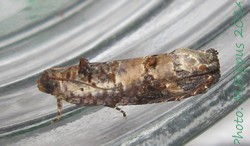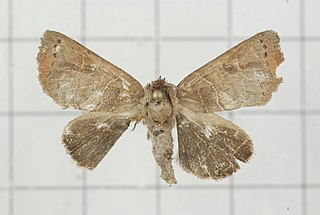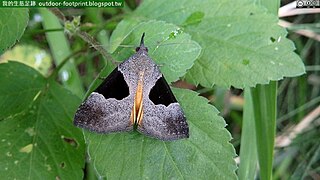Related Research Articles

Nephele hespera, the crepuscular hawkmoth, is a sphingid moth described by Johan Christian Fabricius in 1775.

Theretra silhetensis, the brown-banded hunter hawkmoth, is a moth of the family Sphingidae described by Francis Walker in 1856. It lives in Indo-Australia, India, Sri Lanka, Papua New Guinea, East Australia, Solomon Islands, Fiji Islands, Vanuatu Islands.

Leuroperna sera is a moth of the family Plutellidae first described by Edward Meyrick in 1885. It is found in Japan, Taiwan, Vietnam, Indonesia, India, Sri Lanka, Australia, and New Zealand.

Macroglossum heliophila, the broad-bordered hummingbird hawkmoth, is a moth of the family Sphingidae. It was described by Jean Baptiste Boisduval in 1875. It is found from north-eastern Sikkim, India across southern China to Cheju Island, southern Japan, Taiwan and the Philippines and then south through Vietnam, Thailand, Malaysia and Indonesia to New Guinea and neighbouring islands. It is also known from Queensland, but doubt in Sri Lanka.

Parasa lepida, the nettle caterpillar or blue-striped nettle grub, is a moth of the family Limacodidae that was described by Pieter Cramer in 1799. It is a native minor pest found in the Indo-Malayan region, including India, Sri Lanka, Vietnam, Malaysia and Indonesia. It is an introduced pest to urban trees in western Japan.

Condica dolorosa is a moth of the family Noctuidae. It is found in the Indo-Australian tropics, including Borneo, Hawaii, Hong Kong, India, Sri Lanka, Taiwan and Queensland in Australia.

Dudua aprobola, the mango flower webworm or litchi leaf roller, is a moth of the family Tortricidae. The species was first described by Edward Meyrick in 1886. It is a pest on several economically important crops.
Cyclosia panthona is a moth in the family Zygaenidae. It was described by Caspar Stoll in 1780. It is found in China, Hong Kong, India, Sri Lanka, and Myanmar.
Archips eupatris is a species of moth of the family Tortricidae first described by Edward Meyrick in 1908. It is found in Sri Lanka.
Cnesteboda facilis is a species of moth of the family Tortricidae first described by Edward Meyrick in 1912. It is found in Assam, India.
Dichomeris fungifera is a moth in the family Gelechiidae. It was described by Edward Meyrick in 1913. It is found in Assam in India, northern Vietnam and Jiangxi, China.
Streblote dorsalis is a moth of the family Lasiocampidae first described by Francis Walker in 1866. It is found in India, Sri Lanka, the Philippines, Borneo, Indonesia and Java.
Episparis liturata is a moth of the family Noctuidae first described by George Hampson in 1893. It is found in India, Sri Lanka, Java, Borneo, Myanmar, China and Thailand.

Clostera restitura is a moth of the family Notodontidae first described by Francis Walker in 1865. It is found in Oriental tropics of India, Sri Lanka, and from Hong Kong to Sundaland.
Eublemma pudica is a moth of the family Erebidae first described by Snellen in 1880. It is found in Sri Lanka, India, Fiji and Australia.

Dichromia orosia, sometimes as Dichromia sagitta, is a moth of the family Erebidae first described by Edward Meyrick in 1913. It is found in Sri Lanka and Australia. The caterpillar is a pest of Marsdenia species, Tylophora asthntatica and Tylophora indica.
Dichromia thermesialis is a moth of the family Erebidae first described by Francis Walker in 1866. It is found in India, Sri Lanka, China, Sumatra, Borneo and New Guinea.

Parasa bicolor, the green rice moth, is a moth of the family Limacodidae. The species was first described by Francis Walker in 1855. It is found in Sri Lanka, India, Nepal, Pakistan, Myanmar, Laos, Taiwan, Vietnam, Malaysia, Java, China and Taiwan.
Eucosmophyes icelitodes is a moth of the family Tortricidae first described by Edward Meyrick in 1913. It is found in Sri Lanka.

Earias cupreoviridis, called the cupreous bollworm as a larva, is a moth of the family Nolidae. The species was first described by Francis Walker in 1862. It is found in African countries like Botswana, the Democratic Republic of the Congo, Eritrea, Ethiopia, the Gambia, Kenya, Nigeria, Sierra Leone, South Africa, Togo, Uganda, Zimbabwe to Asian countries like India, Sri Lanka, China, Japan, Korea, Philippines, Indonesia and Hong Kong.
References
- ↑ "Species Details: Pachyrhabda bacterias Meyrick, 1913". Catalogue of Life. Retrieved 29 June 2018.
- ↑ Koçak, Ahmet Ömer; Kemal, Muhabbet (20 February 2012). "Preliminary list of the Lepidoptera of Sri Lanka". Cesa News. Centre for Entomological Studies Ankara (79): 1–57 – via Academia.
- ↑ "Parasa hilaris description". India Biodiversity Portal. Retrieved 28 June 2018.
- ↑ Sreeramu, B. S. (2004). Cultivation of Medicinal and Aromatic Crops. Universities Press. ISBN 9788173715044 – via Google Books.